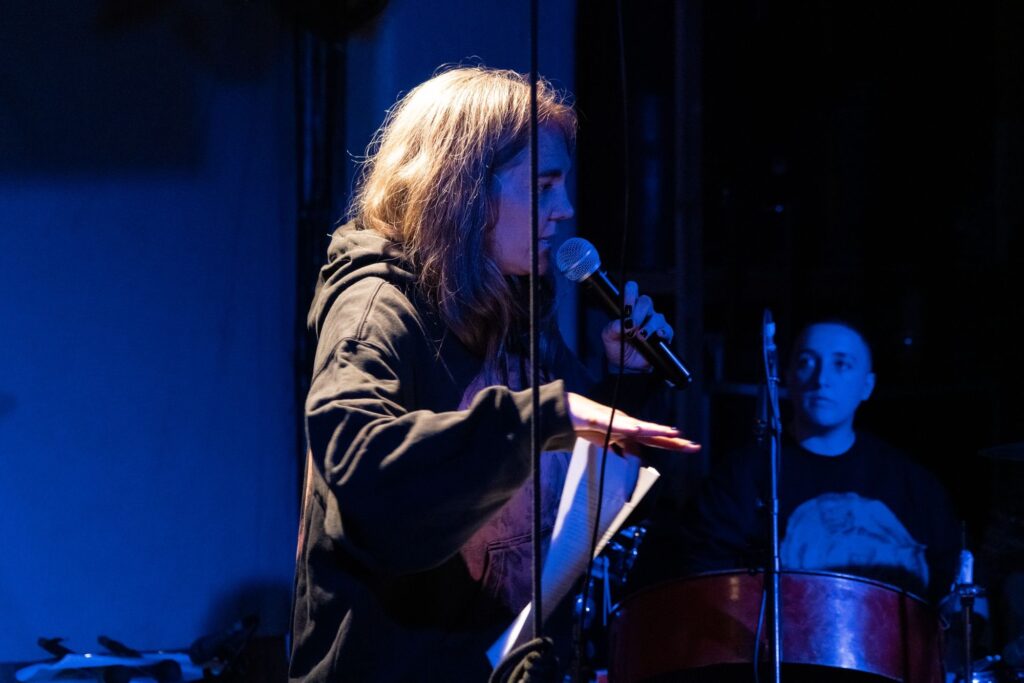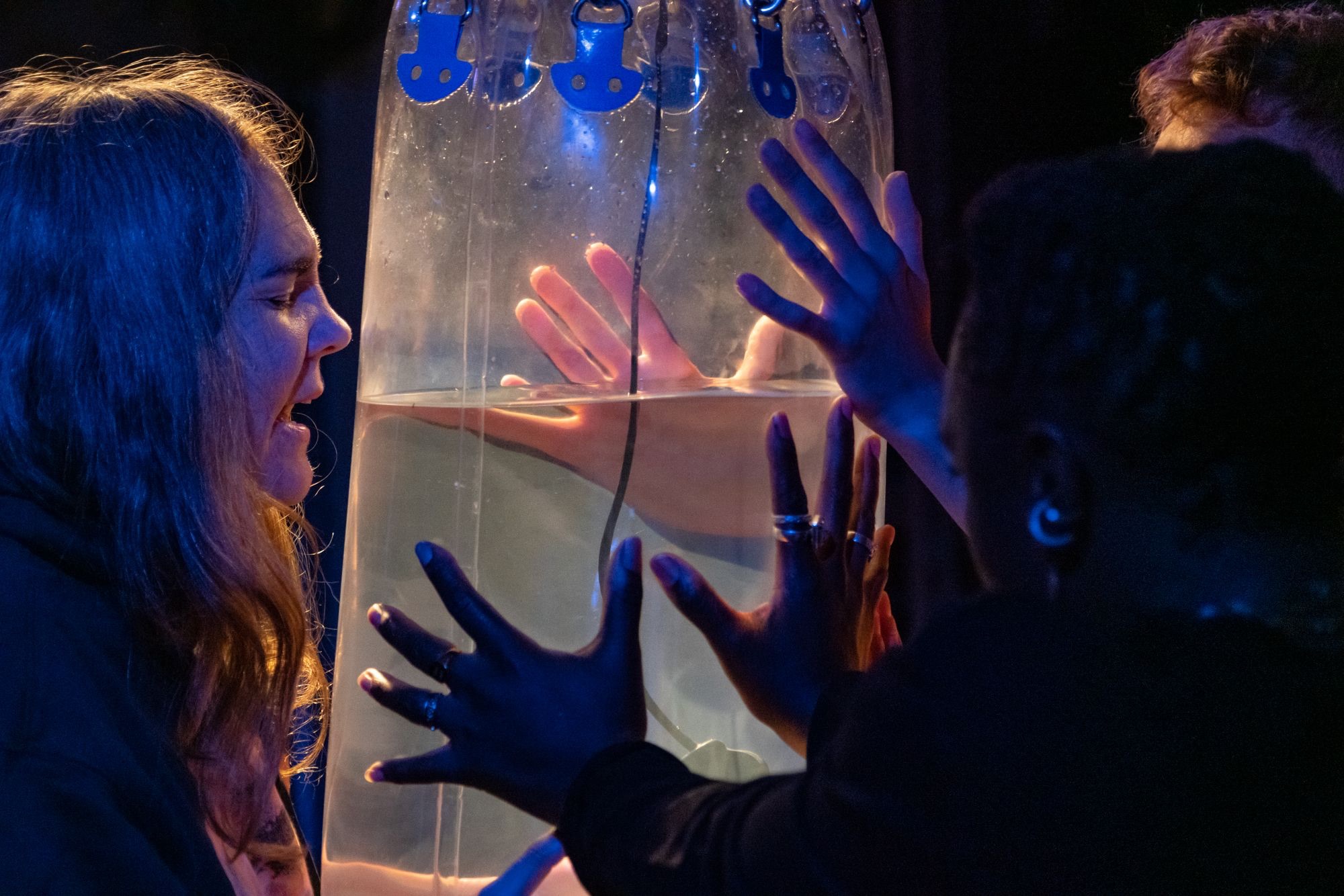This week, composer, singer, choir leader and performance artist Jenny Moore premieres her new work Wild Mix, an immersive choral punk musical that dives into topics including queerness, community, joy and survival. Wild Mix will be presented on 6 November as part of KUNSTY festival at the Southbank Centre, with other ‘underground’ works including BULLYACHE’s WHO HURT YOU?
We caught up with Jenny ahead of the performance to talk about finding joy, what healing looks like onstage and Wild Mix’s giant 50kg boxing bag that’s filled with water…
Q: Tell us about the work Wild Mix? What prompted you to mix all these disciplines into one work?
A: I’m looking for a direct way back into my body. Singing, from the start of me, has been this kind of discipline – an embodied, expressive, experimental, rudimental tool that we all have. I didn’t always feel free with it but singing was, and remains, a kind of top dog of truth-telling and authenticity for me and it makes me feel good. This relationship has been troubled over the years and I put singing away for a good decade of my life before starting F*Choir.
Instead, I started drumming when I was 30. I learnt to play for an impassioned, spur of the moment formation of the punk band Charismatic Megafauna (which I ended up playing in for 8 years!) When I taught myself the drums, something about my body made more sense; I had to lock in, to connect all the limbs, to repeat over and over and over again these beats that were delicious and disgusting and tricky and powerful. Learning to do this was the first time I felt like a full human being, like my mind and my body could be friends — and I started singing again.
I started F*Choir, a 60- piece experimental choir where I compose and arrange for the diverse group of singers using non-gendered voice parts, graphic scores and no auditions to create highly energetic, rhythmic and political music.
Then, I fell in love. The person I fell in love with had just started singing in my choir and one night we found ourselves sharing our tricks, the things that help us come back to ourselves – landing in your own sweet power – and for them, it was kickboxing that opened the channel. It struck me that these rhythmic, hard-hitting, loud but meditative practices (drumming & kickboxing) were the keys that allowed both of us back into singing. Which led us to love and connection. Seemed supernatural, in a way. This person is still the person I’m in love with and they’re the kickboxer in Wild Mix (Sib Trigg). These disciplines are like the tripod of my relational world.
Q: We’re fascinated by the 50kg transparent, water-filled boxing bag – tell us how that came about and what it brings to the performance?
A: I started working with water in 2018 while on a residency with Borealis festival of experimental music in Norway – I had this rogue theory that I was going to learn how to breathe underwater so I could sing while submerged. I started filling up buckets of water and dunking my head in them, experimenting with songs. I stuck a hydrophone in the bucket of water to try and pick up the nuance of my underwater scream and discovered this created an amazing, deep boom when I stepped on the floor close to the bucket. The water as a resonator.
This was brought forward into the development of this piece, it made total sense to me and like a really normal idea, fill a boxing bag with water and mic it from the inside. Because something about the singing and the movement practices are both internal and external. We see / hear them, but the bodies performing them feel something else.
I made a quick drawing of this clear bag (it had to be transparent because I wanted nothing to be hidden, for the sonic magic to be obvious), and showed it to my set designer Kit Falck saying ‘is this possible?’ and she said ‘yes.’
In the performance, the bag is a character all of its own. It’s a boxing bag, yeah, but it’s also the size of my torso, it moves and sounds and breathes and responds and gets pummeled and hugged and handled. It’s tough but really tender. A kind of stand-in for the things we do to ourselves.

Q: What does healing look like to you in the context of this work? And how is that performed/embodied or experienced onstage by the performer and audience?
A: In this work, healing looks like a brief moment of eye contact. Leaning back into someone and knowing they’ll hold you. It looks like repetition, cycles, rehearsal – a ritualistic sense of ‘try again, you’ve got this.’
Funny enough, I’m still ambivalent about healing in general. My most comfortable state of being is Doubtful Mystic. I’m still wondering, what does it feel like? How do you know if you’re healed? We’re in constant motion and interdependence with the earth, oceans, and each other. As soon as I think I’m ‘healed,’ another thing arises.
So, maybe I think healing is embodied in this work through grief. Like, the more you come into integrity – allowing and accepting all the aspects of yourself as a human person – you don’t actually feel ‘better.’ You allow grief in. This is what happened to me when I started to get back in my body. Waves of grief that I’d avoided feeling. And so, maybe, when you start healing, you start grieving, and it’s actually grief that makes you more whole.
“Allow it” is performed and embodied by both the performers and audience in this work. Just allow it.
Q: ‘Figuring out how to feel alive’ (whether that be for survival or joy!) is something that is resonating with me – and others who I have spoken to in the arts right now. What do you do to find joy? And what are you methods of survival?
A: JOY IS HARD. But I’m a big believer in circles. And this means I think finding joy relies on allowing sorrow — you can’t have one side of the circle without the other. The depth of sorrow, fear, anxiety, anger, that I’m feeling about being alive right now are super scary to feel. And that also makes it hard to feel joy, the big feelings are the big feelings!
A mentor and teacher of mine said to me once that so many of us in the arts are deeply broken-hearted – this isn’t what we thought it would be like to be artists. And once you look through that lens, you can’t look back, I see the heartbreak everywhere and then the callouses of trying to cover that up.
So, I find joy through doing this show. Going to choir practice. Playing drums with my friends. Telling my people what I love and crave and want and fear and hate and desire. Usually this starts with crying and ends with laughing, or vice versa.
And survival? Well, that’s in community. It hurts to be seen but we’re not going to make it any other way. Having baths in other peoples’ houses while they do your laundry. Feeling guilty about that and then accepting it. Reading books. Meeting up in person. Deleting instagram. Political organising. Saying sorry. Saying I love you.
Jenny Moore : Wild Mix will be presented at Southbank Centre: Queen Elizabeth Hall’s Purcell Room on Thursday 6 November 2025 at 8.15pm, before touring to Attenborough Centre for the Creative Arts in Brighton on Thursday 29 January 2026. For more information visit: https://www.southbankcentre.co.uk/whats-on/jenny-moore-wild-mix/
